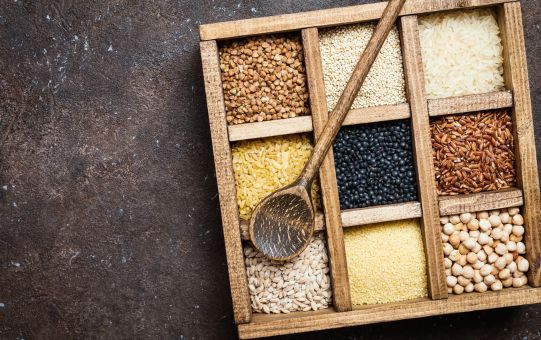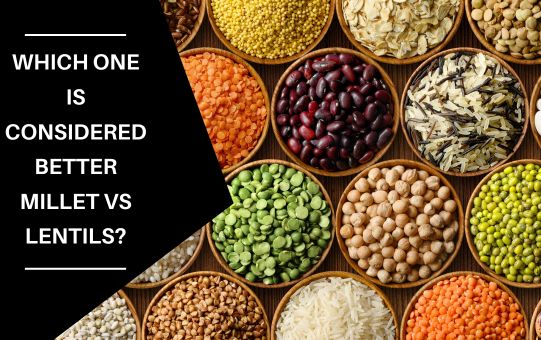Most diet-conscious people wonder which one is considered better millet vs lentils? This blog will help to explore the nutritional values, and cooking methods, and discover delicious recipes using millet and lentils.
Which one is considered better millet vs lentils? Millet and lentils are two popular choices that offer a plethora of health benefits and can be incorporated into a variety of dishes.
This comprehensive article delves into the health benefits and culinary uses of both millet and lentils, unique characteristics of both millet and lentils, examining their nutritional values, culinary uses, and potential health benefits.
By the end, you’ll have a clear understanding of these two superfoods and be better equipped to make a choice that aligns with your dietary preferences and goals.
Contents
Which One is Considered Better: Millet vs Lentils?
Millet and lentils are both highly regarded for their nutritional values and versatility in cooking. However, the answer to which one is considered better ultimately depends on your specific dietary needs and preferences.
Let’s take a closer look at each of these power-packed ingredients to determine their respective merits.
Millet: A Mighty Grain with a Nutritional Punch
Millet, often referred to as a pseudo-grain, is a tiny, gluten-free seed that boasts an impressive nutritional profile. Here’s why millet should be on your radar:
Rich in Nutrients:
Millet is a great source of essential nutrients such as magnesium, phosphorus, copper, and manganese. It also contains B vitamins, which are essential for energy production and overall well-being.
High in Fiber:
With its high fiber content, millet aids in digestion promotes satiety, and supports a healthy gut. Regular consumption of millet may also help manage weight and prevent constipation.
Gluten-Free Alternative:
For individuals with gluten sensitivities or celiac disease, millet serves as an excellent gluten-free alternative to wheat and other grains. It can be used in baking or as a rice substitute.
Lentils: A Legume Powerhouse
Lentils, a type of legume, have been a staple in diets around the world for centuries. Here’s why lentils shine in terms of nutritional benefits:
Protein-Packed:
Lentils are a fantastic plant-based source of protein, making them an excellent option for vegetarians and vegans. They are rich in amino acids, the building blocks of proteins, and can be an integral part of a balanced diet.
Fiber-Rich:
Just like millet, lentils are loaded with dietary fiber, which aids digestion, promotes heart health, and helps regulate blood sugar levels. The high fiber content also contributes to feelings of fullness and can assist in weight management.
Micronutrient Marvel:
Lentils are a great source of iron, folate, potassium, and magnesium. These micronutrients play crucial roles in maintaining optimal health, supporting energy production, and aiding various bodily functions.

Millet vs. Lentils: A Nutritional Comparison
To gain a better understanding of the nutritional values of millet and lentils, let’s compare their key components in the following table:
| Nutrients per 100g | Millet | Lentils |
| Calories | 378 | 116 |
| Carbohydrates | 72g | 20g |
| Calories | 378 | 116 |
| Carbohydrates | 72g | 20g |
| Protein | 11g | 9g |
| Fat | 4g | 0.4g |
| Fiber | 8.5g | 7.9g |
| Iron | 3.9mg | 7.6mg |
| Magnesium | 114mg | 36mg |
As seen from the table, both millet and lentils offer valuable nutrients. Millet contains higher calories and carbohydrates, making it an energy-rich option. On the other hand, lentils are lower in calories and carbohydrates but have slightly higher protein content. Additionally, lentils provide more iron, magnesium, and potassium compared to millet.
It’s important to note that these values may vary depending on the specific type of millet or lentils and the cooking method used. Nonetheless, both millet and lentils contribute to a well-rounded, nutritious diet.
Read Also>>>What Are Differences In Millet Vs Rice Taste?
Culinary Uses and Preparation
Below are some culinary uses and preparation related to millet and lentils:
Millet: Beyond Porridge and Breads
Millet’s versatility shines in the culinary world, offering a range of cooking possibilities. Here are some popular ways to incorporate millet into your meals:
Pilafs and Salads:
Cooked millet can be used as a base for flavorful pilafs or added to salads, adding a delightful nutty flavor and texture.
Breakfast Delights:
Start your day with a warm and comforting bowl of millet porridge, topped with fruits, nuts, and a drizzle of honey or maple syrup.
Baking Adventures:
Millet flour can be used in gluten-free baking, creating delicious muffins, bread, and cookies with a unique taste and texture.
Lentils: Versatile and Satisfying
Lentils offer endless possibilities in the kitchen, and their hearty texture makes them a great addition to a variety of dishes. Here are some ways to make the most of lentils:
Soups and Stews:
Lentils are a staple ingredient in hearty soups and stews, providing a rich, earthy flavor and adding substance to the dish.
Veggie Burgers and Patties:
Combine cooked lentils with vegetables, herbs, and spices to create tasty vegetarian burgers or patties.
Indian Dal:
Lentils are the star of many traditional Indian dal dishes, cooked with aromatic spices and served alongside rice or bread.
Conclusion
In the battle of millet vs. lentils, there is no definitive winner. Both millet and lentils offer a wide array of health benefits, and incorporating them into your diet can contribute to overall well-being. Millet is a gluten-free grain alternative with a rich nutritional profile, while lentils provide plant-based protein and a range of essential minerals.
Read Also>>>WHICH IS BETTER Millet or WHEAT FLOUR
FAQs about Millet and Lentils
Here are few FAQs related to millet and lentils:
Are millet and lentils suitable for gluten-free diets?
Yes, both millet and lentils are naturally gluten-free, making them excellent choices for individuals with gluten sensitivities or celiac disease.
Can millet and lentils help with weight management?
Yes, both millet and lentils are high in fiber, which promotes feelings of fullness and aids in weight management.
Are millet and lentils good sources of protein?
While lentils are known for their protein content, millet also offers a decent amount of plant-based protein, making them both valuable protein sources.
Can millet and lentils be included in a vegetarian or vegan diet?
Absolutely! Millet and lentils are excellent choices for vegetarian and vegan diets due to their nutrient density, including protein, fiber, and various essential minerals. They can serve as valuable plant-based protein sources.

